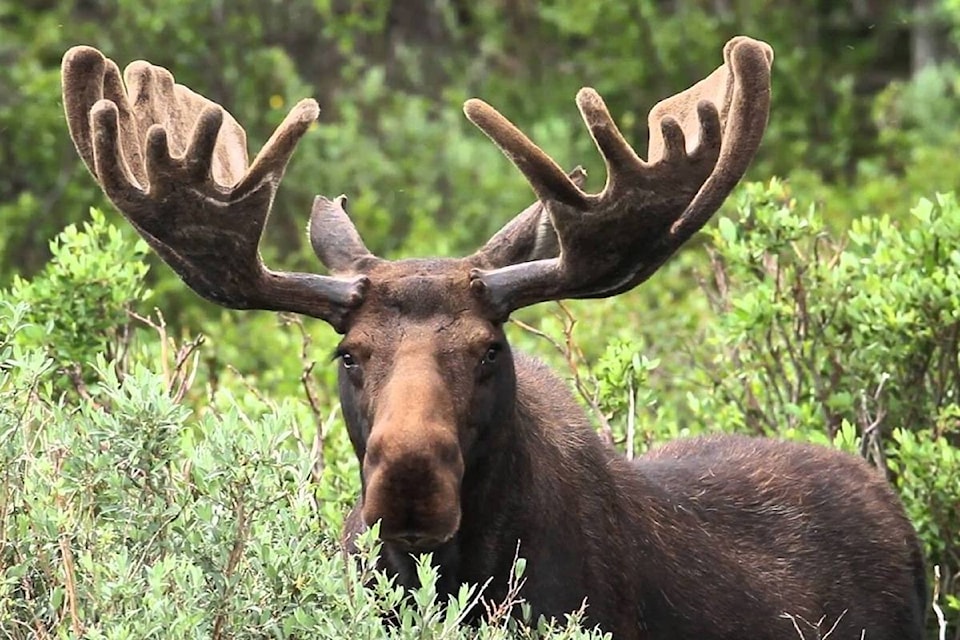Recent moose harvest regulation proposals for the Skeena Region are favouring trophy hunting over the licensed B.C. sustenance hunt for bull moose, according to the Northwest Fish & Wildlife Conservation Association (NFWCA).
The Ministry of Forest, Lands and Natural Resources’ proposed changes for the 2018-19 season include measures for the Skeena South region that would either reduce the general open season from seven days to three days for bull moose, or maintain the general seven-day open season but place an antler-restriction on adolescent bull moose.
Recommendations for North Skeena include antler-restrictions, prohibiting hunters shooting medium-sized animals in favour very young, or very old bull moose with a minimum of ten-pointed antlers.
Ken Franzen, vice-chair for NFWCA, feels these proposals to move away from a general open season for any bull to a ten-point antler restriction will make it a lot more difficult for resident sustenance hunters to find moose fitting that description.
“Our concern is that there is no need for this. Right now non-resident trophy hunters are focused on these big bulls and now the government says the residents should focus on them too, so we don’t have a choice.”
“The other trouble with those big bulls is that they are tough and hard to eat, so my preference is now a smaller bull, but those are the ones off limits from the government,” Franzen said.
These restrictions, namely the ones proposed in the North, will have no effect on guide outfitters or non-resident trophy hunters who primarily look for big, impressive bull moose according to NFWCA President David Lewis. But he said conversations with the Ministry have been increasingly one-sided and has yet to secure a meeting with Minister Doug Donaldson since the proposals were released for feedback.
“It looks like there is no consideration or concern for resident hunters in the area,” Lewis said over the phone. “For the North, the ministry excluded the region in these decisions. They did bring news about the South to us during the summer and were given in a meeting in Smithers, but they made it seem like it was a done deal.”
In a response to a letter from the Prince Rupert Road and Gun Club’s Jan. 16 to BC Premier John Horgan, Eamon O’Donoghue, the regional executive director for the Ministry of Forests, Lands, Natural Resource Operations and Rural Development, wrote “the regulation proposal is intended to proactively address existing and anticipated increased hunter pressure in Skeena North.”
He wrote of the 80 proposed hunting regulation changes in BC, “the changes are intended to alleviate First Nations’ concerns about high use of culturally important areas by licensed hunters.”
But in a letter sent to Minister Doug Donaldson by BC Wildlife Federation (BCWF) President Harvey Andrusak, both of the new proposals are specifically targeted only at local resident harvest. BCWF contends that the issue is not so much one of conservation.
Lewis said the Ministry’s focus on preservation doesn’t line up when looking at moose population data.
“It’s gone totally away from science-based decision making to more socially justified decisions,” he said.
“If it was a conservation issue, that’s a different story, but turning residents into trophy hunters doesn’t make sense.”
With the shortened season in the South, sustenance hunter Edward Luscombe in Terrace said he planned to travel to North Skeena to hunt moose, but proposed antler restrictions in that area will deeply affect his ability to hunt.
“Forcing us to hunt only big antlered bull moose in the North just isn’t right,” Luscombe said over the phone.
Currently, Skeena North is the only area in the province with an extended open season time for moose, which runs from August 20 to October 31, which could lead to more non-residents traveling to the area to participate in commercial trophy hunting. Antler restrictions can also be responsible for countless abandoned dead moose that do not meet the “trophy” criteria.
“People make mistakes, and if you accidentally counted ten points on a bull and you walk up to it and it only has nine, you have two choices,” Franzen said. “You can turn yourself in, or you can just leave… and in a lot of cases, this animal is wasted because of foolish antler restrictions.”
The open season also occurs during the moose-mating season in the fall, when larger, older bulls come down to lower and wetter areas with the hopes of finding a mate. These large-antlered bull moose are the prime breeding males of the species and extremely important to sustaining healthy populations.
At press time, Minister Doug Donaldson was unavailable to comment.
brittany.gervais@terracestandard.com
Like us on Facebook and follow us on Twitter
